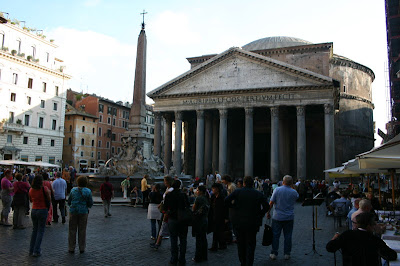Fiumicino, Italy 41° 44.832 N 012° 15.496 E
Rome, Italy 41° 53.638 N 012° 29.707 E
The flight to Fiumicino, Italy from Frankfurt, Germany was about 90 minutes. My luggage made it! It is strange that there was no customs to go thru and I didn’t get a passport stamp. But, uh oh. My luggage was too heavy for me to carry and I needed a cart. I wandered around the cart rack and asked a lady if she spoke English. Luckily, she spoke a little and I managed to convey that I needed a cart and did not know what the procedure was. She was kind enough to explain that it required a Euro and I asked for change. She was kind enough to give it to me, a value of about $1.20 US and would not except an exchange of cash. She said to consider it a gift and if she was ever in the US maybe I could return the favor in kind.
John and Nancy were there to meet me. A short chaotic 10-minute drive in a little 4-door Fiat brought us to Marina Nautilus where S/V Amor Fati, 58’ Bruce Roberts designed motor-sailer was located and we were at the marina. This was a regular run-of-the-mill marina with no frills and all the dirt and noise located on a man made canal that branched off the Tiber River. Amor Fati is tied to the dock and the crew of the boats tied to us walk across our deck to get there.
 |
| John working on the engine in the belly of the beast. |
Tiber (Latin Tiberis; Italian Tevere), river in central Italy, third longest of the country, rising in the Apennines of central Italy, near the source of the Arno River. It flows south in a picturesque, winding course across Umbria and then southwest through Lazio, to empty via a delta in the Tyrrhenian Sea near Rome. The Tiber delta has two channels: the Fiumara, which enters the sea near the site of the ancient port city of Ostia, and the Fiumicino, an artificial waterway used by ships. The Tiber is 252 miles long; the principal cities on its banks are Città di Castello, Rome, and Todi.
The main tributaries of the Tiber are the Nera and Aniene rivers. The Tiber deposits much silt near its mouth, and navigation here is only possible with frequent dredging. Smaller craft are able to use the river from the sea to the confluence of the Nera, about 50 miles north of Rome.
I was on California time, which was 3:18am, and the local time was 9 hours ahead and was 1:20pm. Not feeling too tired and when asked if I wanted to go into Rome I was agreeable. We packed in the little car and made our way to the local train station. After a 35-minute train ride with multiple stops we walked through some terminals and transferred to the subway that serves Rome. We got off at the Colosseu station and walked up the stairs to Rome. The first thing I saw directly across the street was the Colosseum! What an amazing sight to behold. Civilization had moved in and run over this ancient city.
We then proceeded on a walking tour of this part of Rome. John and Nancy were my unofficial tour guides and having been here many times before they were well versed in the history of what I was seeing. Here’s a small bit of that day:
 |
| Piazza Venezia |
 |
| Piazza Di Spagna (The Spanish Steps) |
 |
| Piazza Barberini (where the Internet café was located) |
 |
| Piazza Di Spagna (The Spanish Steps) |




























No comments:
Post a Comment